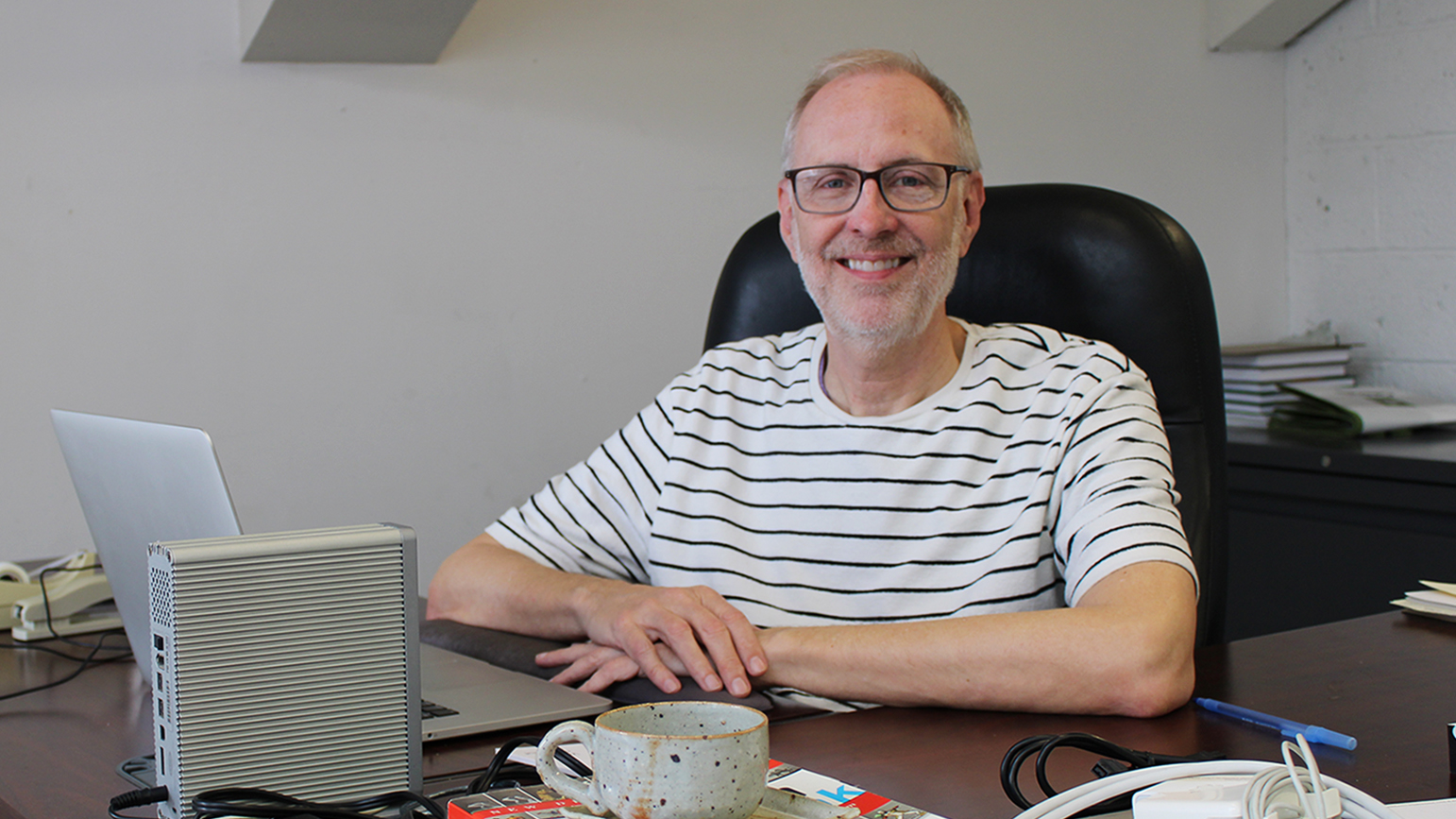
After more than 25 years at the Carnegie Mellon University School of Art, Professor James Duesing is retiring this year. As an artist and a teacher, Duesing has continuously pushed the boundaries of technology for creative expression in animation. Imparting an ethos of experimentation, adaptability, and ingenuity, his students have gone onto prolific careers both as studio artists and as artists and leaders in industry roles. Across the university, both in his teaching and in more administrative roles, he has continuously brought together disparate disciplines, fostering collaboration and ambitious projects.
Duesing came to CMU in 1997 from the University of Cincinnati, where he had been a professor since 1986. As the longest serving faculty member in the Electronic and Time-Based Media (ETB) area, Duesing has played a central role in building one of the most unique and well-respected new media programs in the country. His leadership has brought diverse faculty to CMU whose work and teaching span performance, game design, Bio Art, video, animation, and much more. Rather than focus on building niche technical skills for specific industry roles, the ETB curriculum emphasizes innovative and flexible uses of technology, fostering artists who are both skilled and able to adapt to rapidly shifting technologies. These skills have never been more important than now, with artificial intelligence rapidly shifting the animation and gaming landscape.
As a teacher and colleague, Duesing is beloved for his sharp wit and wry sense of humor, which can belie his profound care for his students and his work. For more than 20 years, Duesing team-taught an advanced animation course with School of Computer Science professor Jessica Hodgins. This unique format gives students the opportunity to build cutting-edge technological skills while simultaneously developing conceptual depth to their work. Moving beyond traditional 2D and 3D animation, the class emphasized out-of-the-box methods of animation, from robotic puppets to AI and more.
Another of Duesing’s most beloved classes was his Social History of Animation. This class explored how animation, an often discounted and ignored medium, reflects upon politics, social conditions, and much more. This course not only gave students a deeper understanding and appreciation for animation’s role in society but encouraged them to think more deeply about the possibilities of the medium in their own work.
During his time at CMU, Duesing has held two leadership roles in interdisciplinary centers: from 1999 to 2002, he was Co-Director of the STUDIO for Creative Inquiry, and from 2014 to 2022, he was Director of the Center for the Arts (CAS) in Society. In both roles, he supported innovative creative projects that brought together faculty from across the university, working to lower the barriers for collaboration between different colleges, schools, and departments. As Director of CAS, he often said his goal was to get everybody at the university to sit at the CAS conference table at least once.
“James Duesing is everything,” said Professor Suzie Silver. “His films have been everywhere for over four decades from MTV to the Museum of Modern Art. As a professor for 38 years, he has mentored generations of successful artists and animators, both students and colleagues, whose impact is far-reaching including in the fine arts, entertainment industry, and higher education. He has always been an inspiring example in every aspect of his roles as artist, professor, and arts leader, showing up, doing an excellent job and bringing integrity and wry humor to every situation. I have been lucky to have been a friend and colleague to Jim for more than twenty years. It’s impossible to overstate what an extraordinary person he is. Listing his accomplishments would take days. And on top of all of it he is a generous host, hilarious friend, a fantastic cook and gardener, and not a bad dancer. We have all been so very lucky to have him at Carnegie Mellon for the past 25 years.”
As an artist, Duesing has continuously been at the technological forefront of animation. He began experimenting with computer animation in 1986 when shopping for a typewriter, he ended up buying a desktop computer instead. His 1990 work, “Maxwell’s Demon” is one of the earliest examples of creative use of desktop computing for animation. With nearly every project, Duesing has challenged himself to experiment with a new technology or a technique, often bending tools in unconventional ways to fit his creative vision. His characters inhabit complex and visually captivating worlds in which he explores human relationships, desires, and emotions, as well as human interactions with technology and the world around them. Through humor and deep emotional complexity, his works evade easy answers and challenge viewers to wrestle with uneasy questions.
Duesing’s work has been broadcast by MTV, PBS, Showtime, and others, and shown at museums and festivals around the world including at the Sundance Film Festival, The Berlin Video Festival, the Hiroshima Animation Festival, Tate Gallery, the Metropolitan Museum of Art, LACMA, and The Museum of Modern Art, just to list a few. He has received numerous awards and grants including Creative Capital, Prix Ars Electronica, an American Film Institute Independent Filmmaker Fellowship, an Emmy Award, and several National Endowment for the Arts grants.
“James Duesing’s teaching has transformed the lives of hundreds of artists working in and beyond animation,” said Head of School Charlie White. “His passion for progress in the medium and his love of experimentation have transformed the field one student at a time, while his work has moved the needle of animation’s form and function in society. Carnegie Mellon’s School of Art is indebted to Jim’s work and wonder, and his vision and visibility. We are grateful for his energy and honored to have him as part of who we are and will always be. We can’t thank him enough!”




